PAINTING ON LOCATION
However, sometimes painting on location can be “interesting,” to say the least.
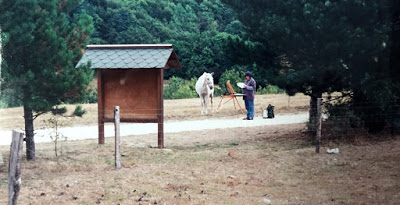

However, sometimes painting on location can be “interesting,” to say the least.

If you are unhappy with a painting or a sketchbook page put it away. Close the book. Just plain get it out of your sight…for awhile. After several days (or longer) take another look and by golly (!) you will see your creation anew. Those wee beings that inhabit the spaces in artist’s storage areas have worked their magic and shazam, it’s not nearly as hopeless a piece of work as you thought!
The sketch done in San Diego’s famous Balboa Park is my most recent example. I was anxious to draw that lovely, complex tower as well as the palm trees which framed the towers so nicely. I was using a new fountain pen which held water soluble ink. The watercolor was added after the drawing.
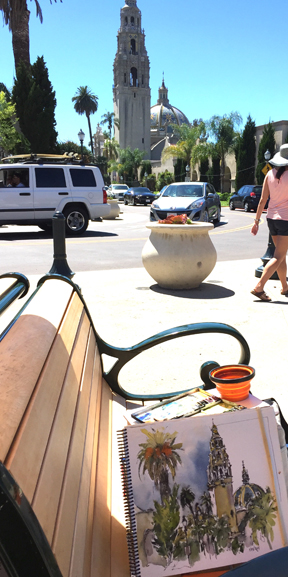 |
| Sketch of Balboa Park – Ink & Watercolor |
 |
| Balboa Park – San Diego |
By the time I re-visited the sketch I found my attitude about it had improved greatly. I was able to look at the sketch itself and NOT what my mind had envisioned at the start of the drawing. The simple base of the tower with it’s sunlit side was a nice contrast to the complexity of the tower top. I added more dark greens, scattered some of the orange color found on the tallest palm tree in areas around the page, added the border on the upper right corner and included the story. Thankfully I had left that blank so it was perfect for the text. And that important white spot on the tower base? If I had left lots more light on the top portion, that space would not be so lovely.
I can’t begin to recall all the times this has happened and I hear others talk about it too. We need distance to be able to judge what we have, not what we don’t have. Until we get to that stage, it does no good to address design problems. I now expect this to happen and stop before I’ve mucked up the whole thing. Distance is a good thing is many respects and very much so in painting. As for those dear little gremlins? I’m grateful they inhabit my flat file!
There is an exercise that I recommend if new painters are wanting to find a way to work that feels more unstructured. You really can’t get too tight when you use the wet-into-wet application of paint.
After drawing the subject on watercolor paper, either immerse the sheet in a tub of water or sponge water on both the front and the back of the paper. With the former, wait several minutes so the paper is thoroughly soaked. Grab the sheet by 2 corners and let the water sluice off the page. Then turn it diagonally so more can drip off. Then “walk” the paper down the board – a board that is non-absorbent. By walking I mean laying the paper down from the bottom to the top making sure that each area is right next to the board. If there is a soft wrinkle, lift the nearest corner and walk it down again Watch for areas where the paper seems to have a bubble beneath the paper and if you see any, lift from the corner and lay it flat again. Any air beneath the watercolor paper will make it more difficult when you begin to paint. If you have used a sponge to wet the paper, do the same method of adhering the paper to the board.
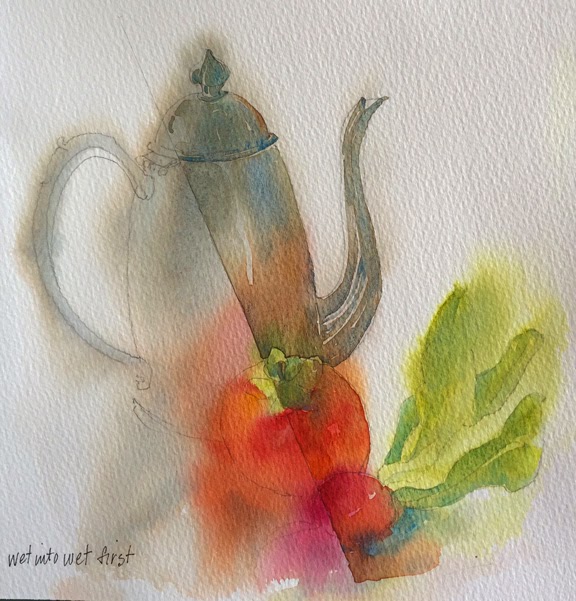 |
| Pewter Teapot & Radish |
One of the wonderful benefits of teaching is that I look for all sorts of ways to explain/show my students the concepts I’m trying to teach. And because of that I’m always exploring and that informs my own work even if it was not the goal. Several years ago I was asked to teach a 3 day workshop and needed to come up with a good final project. Day one was subject matter exploration, composition and drawing in ink; day two added watercolor to the ink drawing and for the final day we added stained paper collage.
Day One
 |
|
| Sharpie & watercolor wash |
That beginning day we worked with all sorts of subject matter in sketchbooks. Sometimes the watercolor wash was added after the drawing was done and sometimes it was done before. In this instance, I used a vertical subject matter in a horizontal format with monochromatic color. That rectangle is 7″x10″, which is the same proportion as a full sheet watercolor paper. This way if you want it to translate to that size, you have begun in the same shape.
By using sharpie, you can’t be too careful with details. The goal was to try several different formats, color schemes, etc.
Day Two
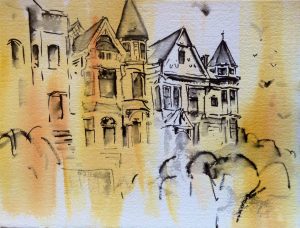 |
|
| Watercolor Underpainting – Ink Brush Drawing |
The watercolor underpainting was done prior to the drawing since the ink brush I was using was water-soluble. I wanted to use this brush since the addition of water creates different values, thereby making it a simpler exercise. Of course it could be done is many different ways and we talked about that, but to get the concept and purpose across, I wanted the initial painting to be done as simply as possible.
Day Three
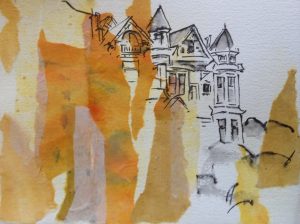 |
| Stained Washi – Ink Brush Drawing |
On the final day, we spent sometime in the morning staining rice paper or washi with our watercolors. While that dried, the plan for the drawing could be done. I usually do not draw with pencil first since that is my preference but several students did that as a first step.
The stained papers were torn is the sizes and shapes according to each painter and then affixed to the heavy watercolor paper with acrylic matte medium. After that has completely dried, the ink drawing was added and water used to create tone. I have purposely left this step unfinished as an example for my students. Our eyes do such a good job of completing line, that it would be interesting to see just how much you could leave out and still have a good readable image.
Watercolor Musings: Necessity becomes the Prompt and Leads to a New Wa…: A number of years ago, just after New Years Day, I decided I needed a unique image for a window display in the gallery, one specifically for…
A number of years ago, just after New Years Day, I decided I needed a unique image for a window display in the gallery, one specifically for Valentine’s Day. I had been doing some watercolor collage which included drawing, watercolor and stained paper collage after taking an inspirational workshop from Jerry Brommer. We had gathered all sorts of collage materials which would be a support for the image in the top third of the page. I found it a creative use of the ephemera collected on trips and sketching days and had done several paintings using this interesting combination. One is even the subject of a previous blog entitled “Everything But the Kitchen Sink,” written in August 2010. I wanted to attack this new project in a different way so I made a list of what I wanted to include: the aforementioned materials, a heart shape used in an abstract way, images of my town of Orange, California and finally little bits of historical notations to add interest.
I chose a square for the format for no other reason than that I like designing in that shape. Then I made what I came to refer to as “postcards” within the page – various shapes of squares and rectangles that would be openings for small paintings of the historic plaza area.
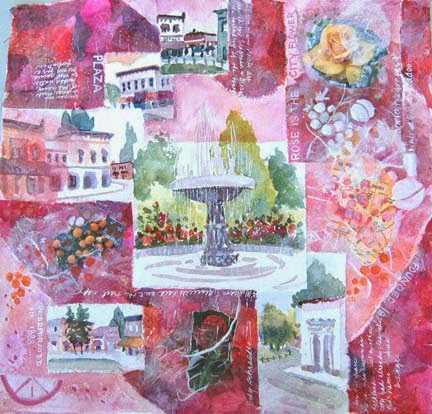 |
| Loving Orange |
I drew the contours of the wee watercolors in lightly with a pencil and then added the large heart shape in the background. Then came the collaged bits of watercolor stained rice paper which was affixed with matte medium – I was careful to keep the medium away from the opening for the images. Also added were photos from maps of the area, pictures of oranges and roses which are the city flower. Then came the small paintings which were of various views of the plaza square which is the center of the historic district. Some of the collaged found papers were veiled with transparent rice papers and others masked by the addition of drawings using white gouache. Finally I added little bits of history by writing on a sheet of typewriter correction paper which had been given to me by an artist friend. I used every inch of that sheet and carefully! I recently found a white pen which works since typewriter correction paper has been impossible to find.
When I began I had no idea how this would turn out but knew that it would be a pleasure to find out. This is a good example of working on a “problem” rather than setting out to do a “wonderful painting.” Setting a limited goal and working toward that end has always been a better way to work for me. I’m concentrating on the problem at hand rather than the final product. You might ask if I’d set myself a lofty goal by wanting something to put in the window and that would be a fair question. However I knew if it didn’t work I could always do it again and or if it really tanked, I just wouldn’t put it up. That desire to have something specifically for Valentine’s Day turned out to be the prompt that opened up a new way to use mixed media and most especially it was such fun to do!
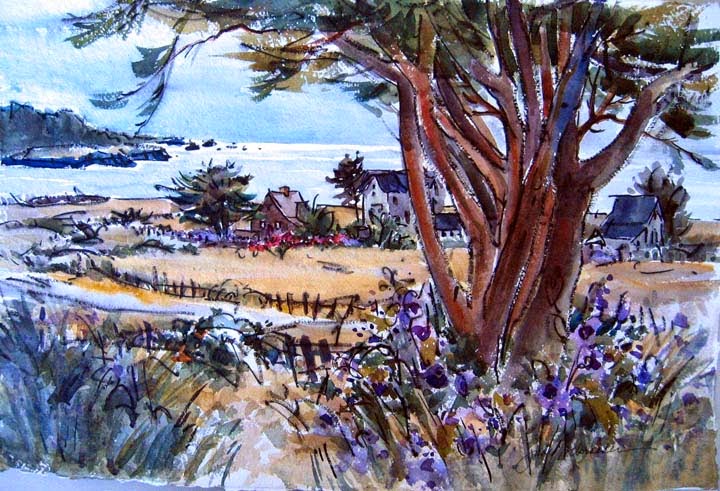 |
|||
| Mendocino done on location years after this story |
We are know that “banding together” and “forming groups” can be very beneficial in people. It is also very helpful when you have isolated elements in a sketchbook page. In the following two examples it is very clear how this works to unify drawing done at different times or under circumstances that do not allow you to move items to your pleasure.
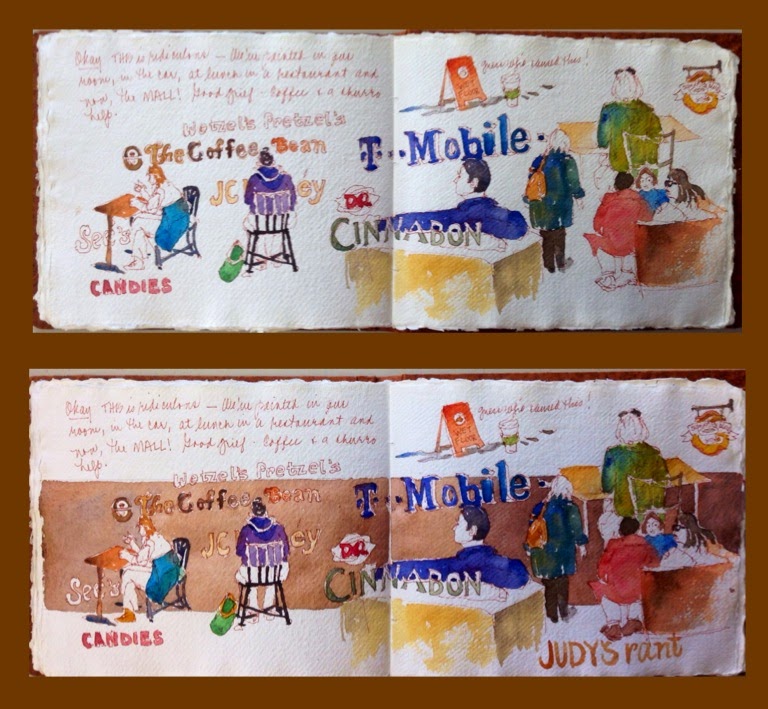 |
| Judy’s Rant |
The scattered page was created when during a long awaited 3 day sketching trip with my painting buddy, Brenda Swenson, where we encountered rain, rain and more rain. We painted outdoors rarely, most often finding places to do what we love but indoors or in-car. NOT my favorite places to paint. She warned me that she was taking me to a place I wouldn’t like and so she did – to a big shopping mall! The sketches of shoppers were captured as people moved in and out of tables and I added signage when I couldn’t get more people. I don’t usually go back and fiddle with these sorts of sketches but I’ve been going through some journals and adding bits here and there and looking at them as design problems. The top page brings back all sorts of memories but I didn’t like it as a sketch. Recently I took another look and decided to add a band behind the central portion of the figures to link them together to make a unified page. After drawing the top and bottom lines, I had to look at the page and the colors used so I didn’t repeat a color and thereby making that image disappear. Like colors and like values, whatever color, make objects recede in importance.
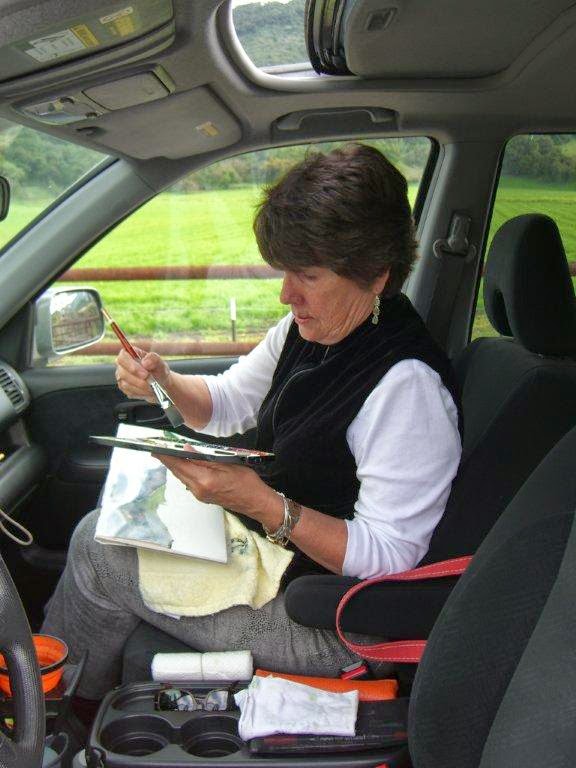 |
| Painting in the Car |
Recently I taught a workshop on Watercolor Journals. On second morning of the 2-day workshop I invited anyone who wanted to join me to meet at The Filling Station, a cafe across the street from the studio. A asked that they bring a pen and journal and find something interesting to draw and later paint. We met early and the 9 of us were perhaps the quietest group they have ever had. Since so many were drawing, no objects were gathered and I ended up with too many isolated elements – again. Banding to the rescue. I chose the pattern of the tablecloth as a background to both animate the page and unify all the elements.
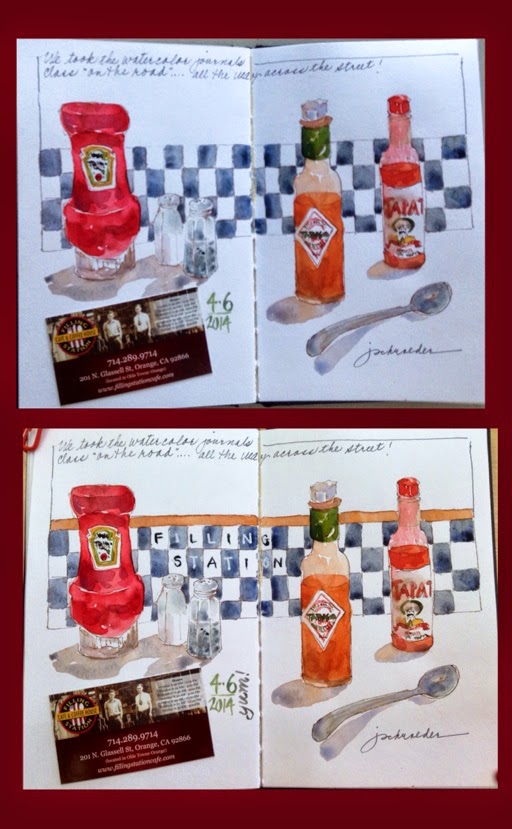 |
||
| The Filling Station |
In the top one, I had just added the background checkered band when I realized I wanted more color and somehow incorporate the name of the restaurant. The name was easy since my checks had the right number of spaces. For the color band above the checks, red was out since the stripe would cross 2 other red items. I chose the burnt orange since it repeated the sauce color in the middle. But look carefully at the shadow areas beneath the bottles in the top one. Then look at the finished piece – I added no more color to those shadows but the orange in them suddenly is more noticeable. Repetition of color is important and this is a good example. I also changed the area to the right of the date. In the journal that date was too far to the left. I didn’t like it at all but there it was. I solved that by adding “Yum!” Probem solved.
So…if you have a page where you need to gather the subject matter and make it more cohesive, try a band. It needn’t be a straight band as in these two examples. It can meander just as well. And the best lesson is that you can paint and draw in all sorts of unusual places. Keep a small journal close at hand. That’s all you need to keep you occupied and happy. I can’t be grumpy if I’m working in a journal no matter the circumstance.
Watercolor Musings: Just What May An Artist Use as Inspiration?: Praha (Prague) – ink brush and watercolor by Judy Schroeder – This is a good example of “suffering” for art. I waited for the ta…
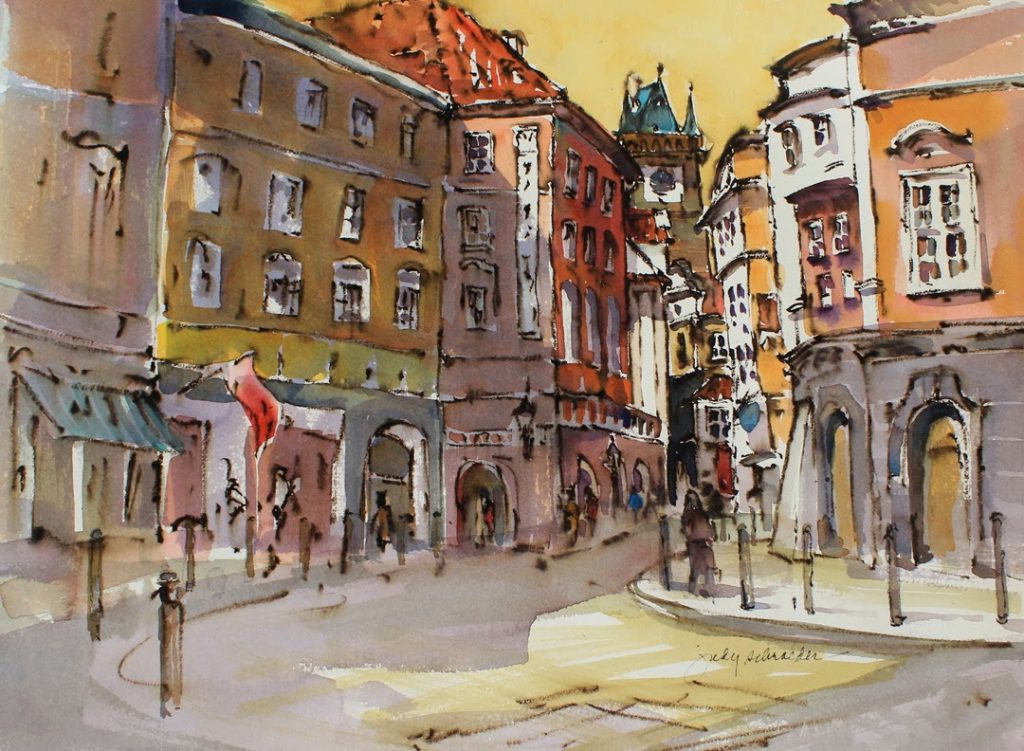 |
| Praha (Prague) – ink brush and watercolor by Judy Schroeder – This is a good example of “suffering” for art. I waited for the table and chair at the gelato shop to be open so I could get this view. Naturally I HAD to buy a gelato! Fair is fair. |
Watercolor Musings: So THEY Say Watercolor is The Most Difficult Mediu…: So THEY Say Watercolor is The Most Difficult Medium. I’m not sure where “THEY” live or pontificate, but THEY have a very …
Watercolor Musings: Finding Gallery Representation: Capistrano Mission Sketch – Ink and Watercolor This article was originally written for the National Watercolor Societ…
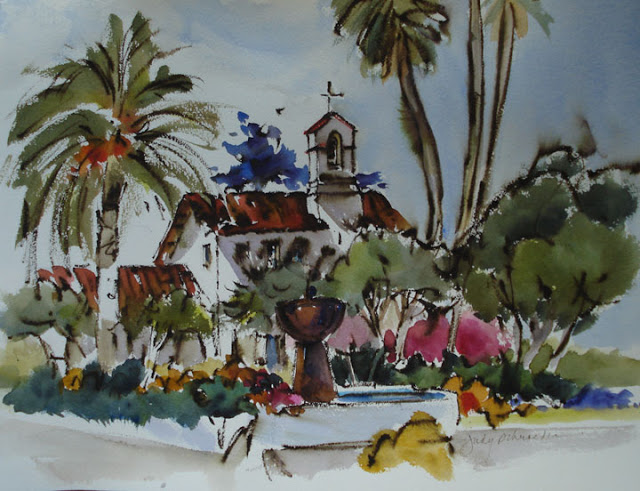 |
Capistrano Mission Sketch – Ink and Watercolor |
Watercolor Musings: From Whence Subject Matter?: I teach a class on March Mondays for a group of painters in South Orange County, California. They meet every Monday morning and ha…